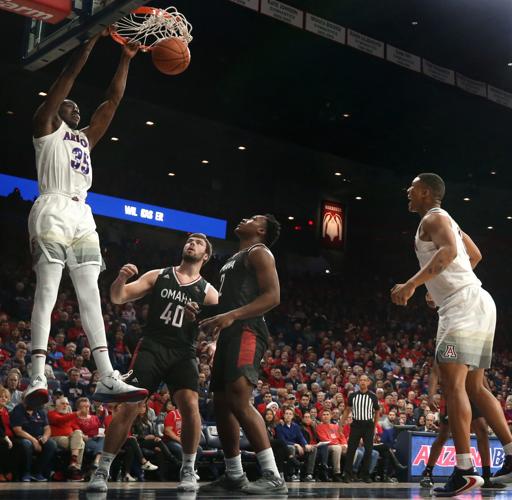With a little context, the 14 offensive rebounds Omaha pulled down Wednesday against Arizona doesn’t really look all that extraordinary.
After all, during Arizona’s 99-49 blowout win, the Mavericks missed 47 shots. That’s an only slightly above-average offensive rebounding percentage of 29.8%.
But it was also Omaha, a low-major team whose tallest rebounder Wednesday was a 6-foot-8-inch workhorse center named Matt Pile.
The opponent wasn’t Gonzaga. But it will be on Saturday.
So UA coach Sean Miller made sure the following message was sent forcefully, even in the wake of a 50-point blowout win Wednesday evening:
“I believe this: Our Achilles’ heel is rebounding,” Miller said. “We’re not good enough at defensive rebounding. We’re not a team that gets a lot of second shots. We’ve been at this for a while, but we have to block out.
“Everybody who plays basketball can block out. Our guards have to rebound better, but so do our bigs. Our starters as a group have to do a better job. So does our bench.”
Miller went on, repeating that rebounding was the “weakness of our team.” He said the blame didn’t fall on anybody, though it might be noted that the shorter Pile (12) out-rebounded UA post starters Chase Jeter (four) and Zeke Nnaji (seven) combined on Wednesday.
Then Miller talked about Gonzaga. Known not only this season for wins already over probable Pac-12 contenders Oregon and Washington, but also for balance and rebounding.
And, last year, for pulling away from Arizona late in their Maui Invitational matchup, beating the Wildcats 91-74.
“I’m familiar with their program,” said Jeter, who had five rebounds despite foul trouble in that game.” We just have to play hard.”
Even with 6-10 standout forward Killian Tillie having missed the first five games of the season because of Oct. 3 knee surgery, the Zags are out-rebounding opponents by 10.4 a game overall, and collect 34.3% of their missed shots, the 37th-best offensive rebounding percentage in the country.
They’re even better on the defensive glass, allowing opponents to collect their missed shots just 20.8% of the time, the fifth-best defensive rebounding percentage, according to Kenpom.
All six of the Zags’ top scorers also average at least four rebounds a game, with Serbian big man Filip Petrusev averaging 10.3 during the Battle 4 Atlantis, where he made the all-tournament team. For the season, Petrusev is averaging 8.5 rebounds, including 3.1 on the offensive end.
Freshman forward Drew Timme, once a top UA recruiting target, averages 2.3 offensive rebounds per game off the bench.
They are the kinds of guys fueling Miller’s concerns.
“When you play a team like Gonzaga who’s very good at getting second shots, they can really win the game and break your back,” Miller said. “When you get a second shot, it’s going to either be a high-percentage 3 or a two. A lot of times you’re going to get fouled, and then the team who gets the most good shots wins. That’s a big advantage.
“So how many second shots teams get against us, I hope we can point toward less and less and less. But there’s no bigger key for our team on Saturday than to keep those guys off the offensive glass. I don’t think they get enough credit in that area.”
It doesn’t help Arizona any that one of its craftier inside players, forward Stone Gettings, still appears doubtful for Saturday because of the concussion and facial fracture he suffered on Nov. 29 against Penn.
Initially kept away from practices and games for fear of exposure to light and noise, Gettings has recovered enough that he returned to the team bench for Wednesday’s game — something Miller acknowledged was a good sign for the Wildcats.
However, Miller said Wednesday that Gettings is still not symptom-free, meaning he hasn’t been cleared to practice fully — and he’s unlikely to play Saturday unless he starts practicing Friday.
“We’ve just got our fingers crossed,” Miller said. “He might be (symptom-free) before Saturday, but it’s too early to tell whether he’d be eligible or able to play on Saturday. I think maybe the more likely game would be the following Saturday (against St. John’s), but he is making a lot of progress so I wouldn’t rule anything out for this weekend.”
The good news for the Wildcats, however, is how Christian Koloko has capitalized on the resulting opportunity Gettings’ injury gave him.
Koloko didn’t play at all in five games earlier this season, including the Wildcats’ first two games of the Wooden Legacy. But after Gettings was hurt in the second game, Koloko was given a minute against Wake Forest and then played nearly 12 against Baylor on Dec. 7, when he had two blocks and three points.
Koloko didn’t grab a rebound against Baylor or in four other of the seven games he played in before Wednesday, but came down with 10 rebounds in less than 12 minutes against the undersized Mavericks. He also had a block and a steal.
“Christian is getting better,” Miller said. “It’s nice that we can sprinkle him in. I think the role that he’s in right now is a big one. He gives us a shot blocker. He gives us another guy that can commit fouls. And Christian has good hands. He’ll catch it and score as well.”
Miller also said Koloko’s shot-blocking ability helps fill a void UA is otherwise not strong in.
But on Saturday, Miller might also need him to pull down a rebound or three. Along with everybody else.





